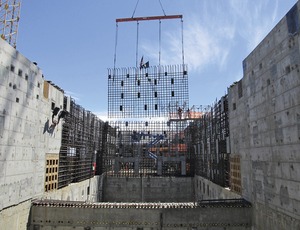
Facing increased pressure over aged, leaking tanks of nuclear waste at its Hanford, Wash., cleanup site and design and construction issues on a multi-billion-dollar on-site treatment plant, the U.S. Energy Dept. aims to move some waste to the underground Waste Isolation Pilot Plant storage site in New Mexico.
DOE proposed last month to ship 3.1 million gallons of mixed transuranic waste from 20 of the 177 underground tanks at the huge Hanford site near the Columbia River. But the plan faces some stiff political and legal opposition. The DOE waste-transfer plan came two weeks after the agency informed officials in Washington and Oregon of new evidence that six underground tanks are leaking.
 |
| WYDEN |
Engineering concerns have slowed plant construction. Work on one portion, the pretreatment facility, is stopped as DOE reassesses and redesigns the entire plant to try to bypass the problematic unit. "The fact that DOE still does not have a plan for getting the waste treatment plant on line is deeply troubling," says Wyden spokesman Keith Chu. He notes board concern about the hydrogen buildup, "an issue DOE has known about for more than 20 years."
In its letter, in addition to pointing out the flammable gas in the tanks and problems with Hanford's safety culture, the board highlighted eight specific treatment-plant safety issues. These had been brought forward before to Congress and to DOE, which is working to resolve them. "Key technical challenges associated with the [pretreatment unit] include operations associated with pulse-jet mixing, strategies for hydrogen in pipes and ancillary vessels and corrosion of pipes and vessels," the board wrote to Wyden. As designed, the facility's design "could lead to nuclear criticality accidents, explosions of flammable gases and mechanical failures of process vessel components."
DOE is working with contractor Bechtel to redesign and mitigate many of the issues at the waste treatment plant, says Jason Bohne, a company spokesman. "We're moving through at various degrees" on the issues, he adds. While DOE has assembled five teams of outside experts to resolve the problems, it is still looking to Bechtel, "as the design authority." In a January letter to then-Washington Gov. Christine Gregoire (D), outgoing DOE chief Steven Chu said that with pretreatment facility work on hold, construction will ramp up on other plant components so DOE can meet a 2019 plant startup commitment to the state.
Bohne says that overall, the facility, including engineering, procurement and construction, is 66% complete. The pretreatment unit is at 41%, while the high-level waste component is at 42%; the low-activity waste unit is at 59%; and the lab is at 76%. About 2,300 employees work on the complex.
In his April 9 confirmation hearing, Energy Secretary-designate Ernest Moniz said treatment-plant design and other technical concerns was the first topic his predecessor raised at a recent meeting between the two. Meanwhile, DOE faces obstacles to shipping Hanford waste to New Mexico, such as getting state approval, with Sen. Tom Udall (D) resistant to the idea. Environmental activist groups have declared the move illegal, claiming WIPP can't take high-level waste.

Post a comment to this article
Report Abusive Comment